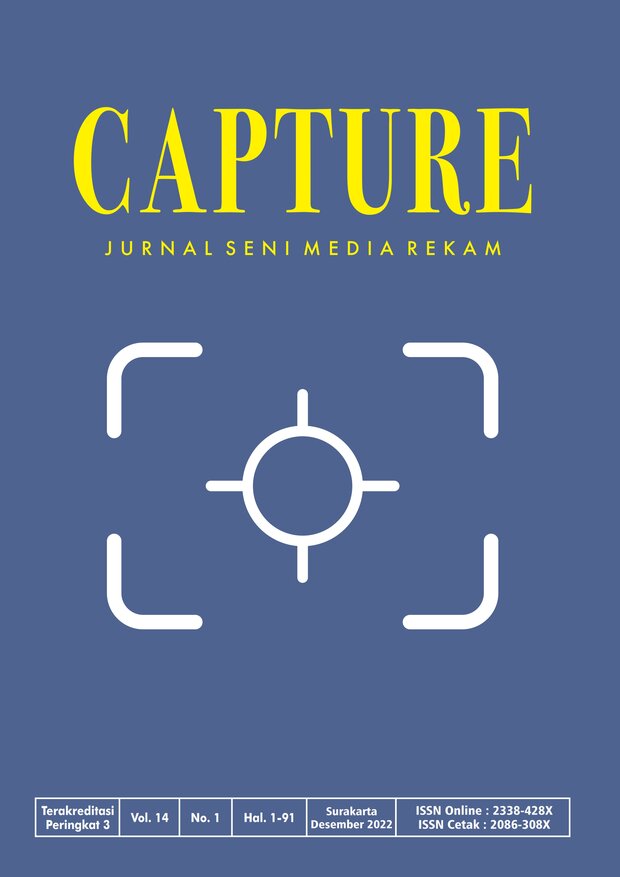THE ANTHROPOMORPHIC-BASED CHARACTER IN THE ANIMATION FILM “AYO MAKAN SAYUR DAN BUAH”
DOI:
https://doi.org/10.33153/capture.v14i1.4560Keywords:
Anthropomorphic, animation character, vegetablesAbstract
Children are arguably less motivated to consume vegetables. At the same time, animated films as learning media are considered effective in evoking emotion and influencing the audience. Consequently, the Ministry of Health of the Republic of Indonesia created the animated film "Ayo Makan Sayur dan Buah" as a campaign to encourage children to consume vegetables. This study seeks to determine the visuals of animated vegetable characters used to motivate children to consume vegetables. This qualitative research employed a case study method referring to the manga matrix theory and the anthropomorphic approach in design review as a data analysis technique. This study's anthropomorphic approach indicates that the design of vegetable characters in the animated film "Ayo Makan Sayur dan Buah" has not been fully optimized to evoke children's emotions because it is still influenced by other verbal messages in the film.
Downloads
References
Anggara, I. G. A. S., Santosa, H., & Udayana, A. A. G. B. (2019). Character Education and Moral Value in 2D Animation Film Entitled “Pendeta Bangau.” CAPTURE Jurnal Seni Media Rekam, 10(2), 57–70. https://doi.org/10.33153/capture.v10i2.2449
Beiman, N. (2013). Prepare to Board! Creating Story and Characters for Animated Features and Shorts (Second Edition). Focal Press, Taylor Francis Group.
Bishko, L. (2014). Animation Principles and Laban Movement Analysis: Movement Frameworks for Creating Emphatic Character Performances. In Nonverbal Communication in Virtual Worlds: Understanding and Designing Expressive Characters. Pittsburgh: ETC Press.
Fitriyani, W., & Sefrina, L. R. (2022). Literature Review: Efektivitas Pendidikan Gizi terhadap Perubahan Perilaku Konsumsi Buah dan Sayur pada Anak-Anak. Jurnal Gizi dan Kesehatan (JGK) Universitas Ngudi Waluyo, 14(1), 43–52.
Giesen, R., & Khan, A. (2018). Acting and Character Animation: The Art of Animated Films, Acting and Visualizing. CRC Press, Taylor & Francis Group.
Hassan, A., & Daniyal, M. (2013). Cartoon Network and its Impact on Behavior of School Going Children: A Case Study of Bahawalpur, Pakistan. International Journal of Management, Economics and Social Sciences (IJMESS), 2(1), 6–11.
Infodatin. (2020). InfoDatin Pusat Data dan Informasi Kementerian Kesehatan RI (12th ed., Vol. 1). Pusat Data dan Informasi Kementerian Kesehatan RI. http://u.lipi.go.id/1426216459
Jadou, S. H., & Ghabra, I. M. M. M. A. (2021). Barthes’ Semiotic Theory and Interpretation of Signs. International Journal of Research in Social Sciences and Humanities, 11(3). https://doi.org/10.37648/ijrssh.v11i03.027
Lefa, B. (2014). The Piaget Theory of Cognitive Development: An Educational Implications. Educational Psychology, 1, 9.
Mulyani, N. (2018). Perkembangan Dasar Anak Usia Dini (Cetakan I). Yogyakarta: Gava Media.
Prakosa, G. (2013). Animasi: Pengetahuan Dasar Film Animasi Indonesia (Cet. 1). Jakarta: Fakultas Film dan Televisi, Institut Kesenian Jakarta - Yayasan Visual Indonesia.
Ramdani, Z. P. (2015). Gesture: Mengungkap Makna di Balik Bahasa Tubuh Orang Lain Dari Mikroekspresi Hingga Makroekspresi. Klaten: Hafamira.
Roberts, S. (2006). Character Animation in 3D: Use Traditional Drawing Techniques to Produce Stunning CGI Animation (reprint 2006). Focal.
Roberts, S. (2011). Character Animation Fundamentals: Developing Skills for 2D and 3D Character Animation. Oxford: Focal Press.
Ruswandi, D. H., & Purwaningsih, D. A. (2021). Designing Anthropomorphic Cat Family Characters in 2D Animated Short Film “Hanyut". IMOVICCON Conference Proceeding, 2(1), 54–63. https://doi.org/10.37312/imoviccon.v2i1.57
Sachari, A., & Sunarya, Y. Y. (2000). Pengantar Tinjauan Desain. Bandung: Penerbit ITB.
Siadari, E. E. (2021). Topik-topik Klasik dan Kontemporer dalam Praktik Menulis. Writing for Life Publishing. hal 32-33.
Sosrojudho, A. A. (2010). Tinjauan Desain Grafis: Dari Revolusi Industri Hingga Indonesia Kini. Concept.
Sugihartono, R. A. (2021). Karakter Animasi Teriantrofis : Transformasi Esensi Teriantrofis Patung dan Relief Garuda. Disertasi, Pascasarjana Institut Seni Indonesia Surakarta.
Tillman, B. (2011). Creative Character Design. UK: Focal Press.
Tsukamoto, H. (2012). Super Manga Matrix. Harper Design, An Imprint of Harper Collins Publishers.
UNICEF. (2021). Programming Guidance: Nutrition in Middle Childhood and Adolescence. United Nations Children’s Fund (UNICEF).
Vygotskij, L. S., Jaroszewska Hall, M., Glick, J., & Rieber, R. W. (1997). The History of the Development of Higher Mental Functions. Plenum.
Wells, P. (1998). Understanding Animation. Routledge.
Wickramasinghe, M. M. T., & Wickramasinghe, M. H. M. (2021). Impact of Using 2D Animation as a Pedagogical Tool. Psychology and Education Journal, 58(1), 3435–3439. https://doi.org/10.17762/pae.v58i1.1283
Winarto, W. P. (2004). Memanfaatkan Tanaman Sayur untuk Mengatasi Aneka Penyakit (Cet. 1). Jakarta: AgroMedia Pustaka.
Wood, M. (2019). The Potential for Anthropomorphism in Communicating Science: Inspiration from Japan. Cultures of Science, 2(1), 23–34. https://doi.org/10.1177/209660831900200103
Xiao, L. (2013). Animation Trends in Education. International Journal of Information and Education Technology, 286–289. https://doi.org/10.7763/IJIET.2013.V3.282
Yoon, Y.-J., Hwang, B. K., Lee, S. J., Lee, J. O., & Chae, H. (2017). Analysis of Seven Animation Characters in Pororo the Little Penguin with Sasang Typology. Integrative Medicine Research, 6(2), 156–164. https://doi.org/10.1016/j.imr.2017.02.002
Yulianti, N. R., Wahyuningrum, E., Gayatina, A. K., & Erawati, M. (2021). Children’s Opinion on Vegetables Consumption: A Qualitative Study on School-Agers in City of Semarang. Indonesian Journal of Applied Research (IJAR), 2(2), 117–125. https://doi.org/10.30997/ijar.v2i2.126
Zeman, N. B. (2017). Storytelling for Interactive Digital Media and Video Games. Florida: Taylor & Francis.
Downloads
Published
Issue
Section
License
Copyright (c) 2022 Pebriyanto Pebriyanto, Hafiz Aziz Ahmad, Hafiz Aziz Ahmad, Irfansyah Irfansyah, Irfansyah Irfansyah

This work is licensed under a Creative Commons Attribution-ShareAlike 4.0 International License.
Copyright
Authors who publish with Capture: Jurnal Seni Media Rekam agree to the following terms:
- Authors retain copyright and grant the journal right of first publication with the work simultaneously licensed under a Creative Commons Attribution License (CC BY-SA 4.0) that allows others to share the work with an acknowledgment of the work's authorship and initial publication in this journal.
- Authors are able to enter into separate, additional contractual arrangements for the non-exclusive distribution of the journal's published version of the work (e.g., post it to an institutional repository or publish it in a book), with an acknowledgment of its initial publication in this journal.







